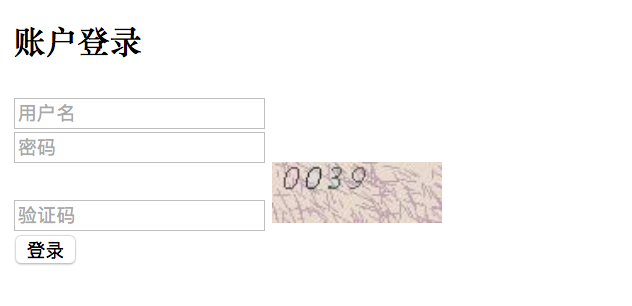【推荐】2019 Java 开发者跳槽指南.pdf(吐血整理) >>> 
添加验证码大致可以分为三个步骤:根据随机数生成验证码图片;将验证码图片显示到登录页面;认证流程中加入验证码校验。Spring Security的认证校验是由UsernamePasswordAuthenticationFilter过滤器完成的,所以我们的验证码校验逻辑应该在这个过滤器之前。下面一起学习下如何在上一节Spring Security自定义用户认证的基础上加入验证码校验功能。
生成图形验证码
验证码功能需要用到spring-social-config依赖:
<dependency>
<groupId>org.springframework.social</groupId>
<artifactId>spring-social-config</artifactId>
</dependency>首先定义一个验证码对象ImageCode:
public class ImageCode {
private BufferedImage image;
private String code;
private LocalDateTime expireTime;
public ImageCode(BufferedImage image, String code, int expireIn) {
this.image = image;
this.code = code;
this.expireTime = LocalDateTime.now().plusSeconds(expireIn);
}
public ImageCode(BufferedImage image, String code, LocalDateTime expireTime) {
this.image = image;
this.code = code;
this.expireTime = expireTime;
}
public boolean isExpire() {
return LocalDateTime.now().isAfter(expireTime);
}
// get,set 略
}ImageCode对象包含了三个属性:image图片,code验证码和expireTime过期时间。isExpire方法用于判断验证码是否已过期。
接着定义一个ValidateController,用于处理生成验证码请求:
@RestController
public class ValidateController {
public final static String SESSION_KEY_IMAGE_CODE = "SESSION_KEY_IMAGE_CODE";
private SessionStrategy sessionStrategy = new HttpSessionSessionStrategy();
@GetMapping("/code/image")
public void createCode(HttpServletRequest request, HttpServletResponse response) throws IOException {
ImageCode imageCode = createImageCode();
sessionStrategy.setAttribute(new ServletWebRequest(request), SESSION_KEY_IMAGE_CODE, imageCode);
ImageIO.write(imageCode.getImage(), "jpeg", response.getOutputStream());
}
}createImageCode方法用于生成验证码对象,org.springframework.social.connect.web.HttpSessionSessionStrategy对象封装了一些处理Session的方法,包含了setAttribute、getAttribute和removeAttribute方法,具体可以查看该类的源码。使用sessionStrategy将生成的验证码对象存储到Session中,并通过IO流将生成的图片输出到登录页面上。
其中createImageCode方法代码如下所示:
private ImageCode createImageCode() {
int width = 100; // 验证码图片宽度
int height = 36; // 验证码图片长度
int length = 4; // 验证码位数
int expireIn = 60; // 验证码有效时间 60s
BufferedImage image = new BufferedImage(width, height, BufferedImage.TYPE_INT_RGB);
Graphics g = image.getGraphics();
Random random = new Random();
g.setColor(getRandColor(200, 250));
g.fillRect(0, 0, width, height);
g.setFont(new Font("Times New Roman", Font.ITALIC, 20));
g.setColor(getRandColor(160, 200));
for (int i = 0; i < 155; i++) {
int x = random.nextInt(width);
int y = random.nextInt(height);
int xl = random.nextInt(12);
int yl = random.nextInt(12);
g.drawLine(x, y, x + xl, y + yl);
}
StringBuilder sRand = new StringBuilder();
for (int i = 0; i < length; i++) {
String rand = String.valueOf(random.nextInt(10));
sRand.append(rand);
g.setColor(new Color(20 + random.nextInt(110), 20 + random.nextInt(110), 20 + random.nextInt(110)));
g.drawString(rand, 13 * i + 6, 16);
}
g.dispose();
return new ImageCode(image, sRand.toString(), expireIn);
}
private Color getRandColor(int fc, int bc) {
Random random = new Random();
if (fc > 255) {
fc = 255;
}
if (bc > 255) {
bc = 255;
}
int r = fc + random.nextInt(bc - fc);
int g = fc + random.nextInt(bc - fc);
int b = fc + random.nextInt(bc - fc);
return new Color(r, g, b);
}生成验证码的方法写好后,接下来开始改造登录页面。
改造登录页
在登录页面加上如下代码:
<span style="display: inline">
<input type="text" name="imageCode" placeholder="验证码" style="width: 50%;"/>
<img src="/code/image"/>
</span><img>标签的src属性对应ValidateController的createImageCode方法。
要使生成验证码的请求不被拦截,需要在BrowserSecurityConfig的configure方法中配置免拦截:
@Override
protected void configure(HttpSecurity http) throws Exception {
http.formLogin() // 表单登录
// http.httpBasic() // HTTP Basic
.loginPage("/authentication/require") // 登录跳转 URL
.loginProcessingUrl("/login") // 处理表单登录 URL
.successHandler(authenticationSucessHandler) // 处理登录成功
.failureHandler(authenticationFailureHandler) // 处理登录失败
.and()
.authorizeRequests() // 授权配置
.antMatchers("/authentication/require",
"/login.html",
"/code/image").permitAll() // 无需认证的请求路径
.anyRequest() // 所有请求
.authenticated() // 都需要认证
.and().csrf().disable();
}login.html随便改一下
<!DOCTYPE html>
<html>
<head>
<meta charset="UTF-8">
<title>登录</title>
</head>
<body>
<form style="width: 50%" action="/login" method="post">
<div class="form">
<h3>账户登录</h3>
<input type="text" placeholder="用户名" name="username" required="required"/>
<br>
<input type="password" placeholder="密码" name="password" required="required"/>
<br>
<span style="display: inline">
<input type="text" name="imageCode" placeholder="验证码" style="height: 100%;"/>
<img src="/code/image"/>
</span>
<br>
<button type="submit">登录</button>
</div>
</form>
</body>
</html>重启项目,访问http://localhost:8080/login.html,效果如下:

认证流程添加验证码校验
在校验验证码的过程中,可能会抛出各种验证码类型的异常,比如“验证码错误”、“验证码已过期”等,所以我们定义一个验证码类型的异常类:
import org.springframework.security.core.AuthenticationException;
public class ValidateCodeException extends AuthenticationException {
private static final long serialVersionUID = 5022575393500654458L;
public ValidateCodeException(String message) {
super(message);
}
}注意,这里继承的是AuthenticationException而不是Exception。
我们都知道,Spring Security实际上是由许多过滤器组成的过滤器链,处理用户登录逻辑的过滤器为UsernamePasswordAuthenticationFilter,而验证码校验过程应该是在这个过滤器之前的,即只有验证码校验通过后采去校验用户名和密码。由于Spring Security并没有直接提供验证码校验相关的过滤器接口,所以我们需要自己定义一个验证码校验的过滤器ValidateCodeFilter:
public class ValidateCodeFilter extends OncePerRequestFilter {
@Autowired
private AuthenticationFailureHandler authenticationFailureHandler;
private SessionStrategy sessionStrategy = new HttpSessionSessionStrategy();
@Override
protected void doFilterInternal(HttpServletRequest httpServletRequest, HttpServletResponse httpServletResponse,
FilterChain filterChain) throws ServletException, IOException {
if (StringUtils.startsWithIgnoreCase("/login", httpServletRequest.getRequestURI())
&& StringUtils.startsWithIgnoreCase(httpServletRequest.getMethod(), "post")) {
try {
validateCode(new ServletWebRequest(httpServletRequest));
} catch (ValidateCodeException e) {
authenticationFailureHandler.onAuthenticationFailure(httpServletRequest, httpServletResponse, e);
return;
}
}
filterChain.doFilter(httpServletRequest, httpServletResponse);
}
private void validateCode(ServletWebRequest servletWebRequest) throws ServletRequestBindingException {
//
}
}ValidateCodeFilter继承了org.springframework.web.filter.OncePerRequestFilter,该过滤器只会执行一次。
在doFilterInternal方法中我们判断了请求URL是否为/login,该路径对应登录form表单的action路径,请求的方法是否为POST,是的话进行验证码校验逻辑,否则直接执行filterChain.doFilter让代码往下走。当在验证码校验的过程中捕获到异常时,调用Spring Security的校验失败处理器AuthenticationFailureHandler进行处理。
validateCode的校验逻辑如下所示:
private void validateCode(ServletWebRequest servletWebRequest) throws ServletRequestBindingException {
ImageCode codeInSession = (ImageCode) sessionStrategy.getAttribute(servletWebRequest, ValidateController.SESSION_KEY_IMAGE_CODE);
String codeInRequest = ServletRequestUtils.getStringParameter(servletWebRequest.getRequest(), "imageCode");
if (StringUtils.isEmpty(codeInRequest)) {
throw new ValidateCodeException("验证码不能为空!");
}
if (codeInSession == null) {
throw new ValidateCodeException("验证码不存在!");
}
if (codeInSession.isExpire()) {
sessionStrategy.removeAttribute(servletWebRequest, ValidateController.SESSION_KEY_IMAGE_CODE);
throw new ValidateCodeException("验证码已过期!");
}
if (!StringUtils.startsWithIgnoreCase(codeInSession.getCode(), codeInRequest)) {
throw new ValidateCodeException("验证码不正确!");
}
sessionStrategy.removeAttribute(servletWebRequest, ValidateController.SESSION_KEY_IMAGE_CODE);
}我们分别从Session中获取了ImageCode对象和请求参数imageCode(对应登录页面的验证码<input>框name属性),然后进行了各种判断并抛出相应的异常。当验证码过期或者验证码校验通过时,我们便可以删除Session中的ImageCode属性了。
验证码校验过滤器定义好了,怎么才能将其添加到UsernamePasswordAuthenticationFilter前面呢?很简单,只需要在BrowserSecurityConfig的configure方法中添加些许配置即可:
@Autowired
private ValidateCodeFilter validateCodeFilter;
@Override
protected void configure(HttpSecurity http) throws Exception {
http.addFilterBefore(validateCodeFilter, UsernamePasswordAuthenticationFilter.class) // 添加验证码校验过滤器
.formLogin() // 表单登录
// http.httpBasic() // HTTP Basic
.loginPage("/authentication/require") // 登录跳转 URL
.loginProcessingUrl("/login") // 处理表单登录 URL
.successHandler(authenticationSucessHandler) // 处理登录成功
.failureHandler(authenticationFailureHandler) // 处理登录失败
.and()
.authorizeRequests() // 授权配置
.antMatchers("/authentication/require",
"/login.html",
"/code/image").permitAll() // 无需认证的请求路径
.anyRequest() // 所有请求
.authenticated() // 都需要认证
.and().csrf().disable();
}上面代码中,我们注入了ValidateCodeFilter,然后通过addFilterBefore方法将ValidateCodeFilter验证码校验过滤器添加到了UsernamePasswordAuthenticationFilter前面。
大功告成,重启项目,访问http://localhost:8080/login.html,当随便入验证码时点击登录,页面显示如下:

当页面加载60秒后再输入验证码点击登录,页面显示如下

当验证码通过,并且用户名密码正确时,页面显示如下:

源码:https://gitee.com/hekang_admin/security-demo2.git
来源:oschina
链接:https://my.oschina.net/u/1046143/blog/3146309